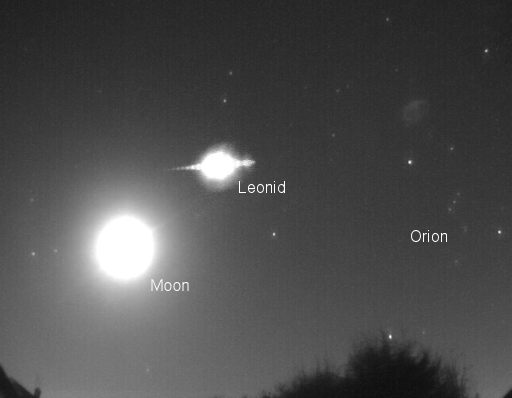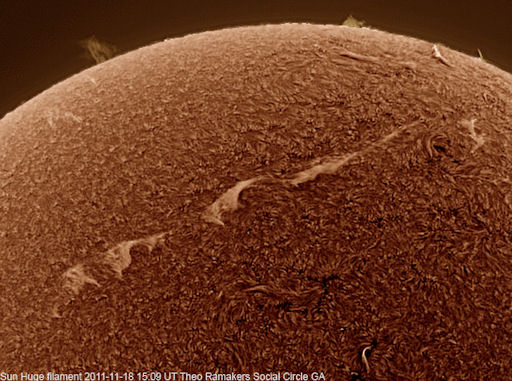Turn your cell phone into a field-tested satellite tracker. Works for Android and iPhone. | | | LEONID METEOR UPDATE: According to the International Meteor Organization, this year's Leonid meteor shower peaked on Nov. 18th with a maximum rate of ~18 meteors per hour. That's not many (especially compared to the Leonid storms of a decade ago), but sometimes just one Leonid can be enough. In Chelmsford, UK, astronomer Nick James caught this fireball lighting up the sky almost as brightly as the Moon: 
Across the Atlantic in New Jersey, photographer Jeff Berke enjoyed a similar Leonid moment: "I saw a Leonid Fireball around 4:20am that lit up the sky creating shadows and a smoke trail which lasted close to 45 seconds. It was an incredible night!" The shower is subsiding as Earth exits the debris stream of parent Comet Tempel-Tuttle. Tune into SpaceWeather Radio for farewell echoes. more Leonids: from Peter Meadows of Chelmsford, Essex, UK; from Christopher Handler of Largs Bay, Adelaide, South Australia; from Jett Aguilar of Quezon City, Philippine; from Dr Salvador Aguirre of Hermosillo, Sonora, Mexico; from Sylvain Weiller of Saitn Remy lès Chevreuse, France GREAT FILAMENT: It's one of the biggest things in the entire solar system. A dark filament of magnetism measuring more than 700,000 km from end to end is sprawled diagonally across the face of the sun. Amateur astronomer Theo Ramakers photographed the structure yesterday from Social Circle, Georgia: 
"What a beautiful view," says Ramakers. "Wow--would I like to image this if/when it collapses! Can’t wait to see what tomorrow will bring." Indeed, the future could bring some action. Filaments like these have a habit of collapsing, and when they fall to the stellar surface the impact can trigger a Hyder flare. Readers with solar telescopes are encouraged to monitor developments. more images: from John Stetson of Falmouth, Maine; from Craig & Tammy Temple of Hendersonville, Tennessee; from Coute of Chateaugay, France Potentially Hazardous Asteroids ( PHAs) are space rocks larger than approximately 100m that can come closer to Earth than 0.05 AU. None of the known PHAs is on a collision course with our planet, although astronomers are finding new ones all the time. On November 19, 2011 there were 1256 potentially hazardous asteroids. Recent & Upcoming Earth-asteroid encounters: | Asteroid | Date(UT) | Miss Distance | Mag. | Size | | 2011 FZ2 | Nov 7 | 75.9 LD | -- | 1.6 km | | 2005 YU55 | Nov 8 | 0.8 LD | 11.2 | 400 m | | 2011 UT91 | Nov 15 | 9.9 LD | -- | 109 m | | 1994 CK1 | Nov 16 | 68.8 LD | -- | 1.5 km | | 1996 FG3 | Nov 23 | 39.5 LD | -- | 1.1 km | | 2003 WM7 | Dec 9 | 47.6 LD | -- | 1.6 km | | 1999 XP35 | Dec 20 | 77.5 LD | -- | 1.0 km | | 2000 YA | Dec 26 | 2.9 LD | -- | 80 m | | 2011 SL102 | Dec 28 | 75.9 LD | -- | 1.1 km | Notes: LD means "Lunar Distance." 1 LD = 384,401 km, the distance between Earth and the Moon. 1 LD also equals 0.00256 AU. MAG is the visual magnitude of the asteroid on the date of closest approach. | | The official U.S. government space weather bureau | | | The first place to look for information about sundogs, pillars, rainbows and related phenomena. | | | Researchers call it a "Hubble for the sun." SDO is the most advanced solar observatory ever. | | | 3D views of the sun from NASA's Solar and Terrestrial Relations Observatory | | | Realtime and archival images of the Sun from SOHO. | | | from the NOAA Space Environment Center | | | the underlying science of space weather | | 
